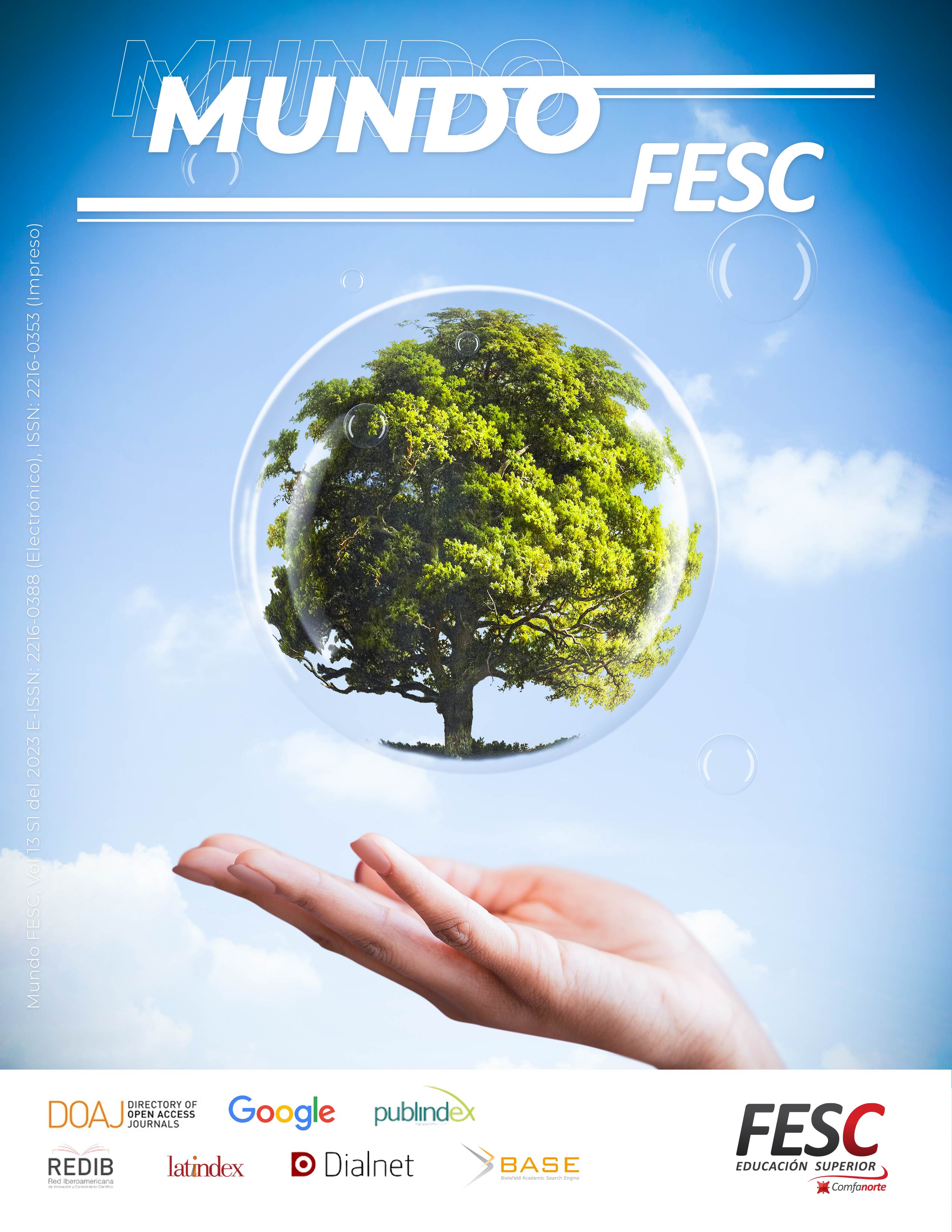Impact Of Road Deterioration On The Health Of The Inhabitants Of Carrera 12 Via The Transport Terminal Aguachica Cesar
DOI:
https://doi.org/10.61799/2216-0388.1727Keywords:
Dengue, Hearing Pollution, Mesh Road, Particulate Matter, Stagnant WaterAbstract
In Aguachica-Cesar there are multiple problems, among which stand out those produced by the deterioration of the road network and heavy load traffic within the urban perimeter. In this qualitative study, the effect of environmental conditions in the sector of Carrera 12 between 10th and 8th streets was analyzed by applying a survey to inhabitants of the sector, in which they were asked about symptoms associated with exposure to certain contaminating factors. The results showed that more than 85% of those surveyed reported presenting some symptoms related to noise pollution factors, such as stress, insomnia, anxiety and headaches; while more than 90% presented symptoms associated with exposure to particulate matter. Finally, more than 90% of the inhabitants surveyed reported having had knowledge of diseases such as Dengue, Zika, Chikungunya and skin diseases caused by the stagnation of rainwater.
Downloads
References
[1] R. Al-Tohamy, S. Ali, F. Li, K. Okasha, Y. Mahmoud, T. Elsamahy, H. Jiao, Y. Fu, y J. Sun, “A critical review on the treatment of dye-containing wastewater: Ecotoxicological and health concerns of textile dyes and possible remediation approaches for environmental safety”, Ecotoxicology and Environmental Safety, 231, 113-160, 2022. https://doi.org/10.1016/j.ecoenv.2021.113160 DOI: https://doi.org/10.1016/j.ecoenv.2021.113160
[2] C. Mora, J. Villamizar, y N. Cañas, “Turismo de salud como opción de aumento de la oferta de servicios en San José de Cúcuta”, Revista Visión Internacional, vol 7, no. 1, pp. 46-63. DOI: https://doi.org/10.22463/27111121.3363 DOI: https://doi.org/10.22463/27111121.3363
[3] M. Ramírez, J. Hernández, Z. Nieto, y A. Bravo, “Comprender la salud para atender la vida: insinuaciones pedagógicas que indisciplinan la relación ciencia–saber para transformar los aprendizajes”, Perspectivas, vol. 8, no. S2, pp. 99-109, 2023. DOI: https://doi.org/10.22463/25909215.4606 DOI: https://doi.org/10.22463/25909215.4606
[4] Organizacion Mundial de la Salud, Estadísticas sanitarias mundiales 2024: seguimiento de la salud para los ODS y los objetivos de desarrollo sostenible, Editores Organización Mundial de la Salud, ISBN 9789240094703. 2024. https://www.who.int/publications/i/item/9789240094703 [Acseso dic-12-2024]
[5] Organización Mundial de la Salud. (2020). Estadísticas Sanitarias Mundiales 2020. In OMS, Vol. 1, Issue 2, 2020. https://apps.who.int/iris/bitstream/handle/10665/338072/9789240011953-spa.pdf?sequence=1&isAllowed=y%22 [Acseso dic-19-2024]
[6] M. Riedl, & D. Diaz-Sanchez, “Biology of diesel exhaust effects on respiratory function”, Journal of Allergy and Clinical Immunology, 115(2), 221–228, 2005. https://doi.org/10.1016/j.jaci.2004.11.047 DOI: https://doi.org/10.1016/j.jaci.2004.11.047
[7] R. Valiente, “Colectivos decuidadores comunitarios de la salud mental:Unapoyopsicológicoparapersonasenduelopor la pandemia de COVID−19. Revista Temario Científico 2 (1), pp. 24−38, 2022. DOI: https://doi.org/10.47212/rtcAlinin.1.2.3 DOI: https://doi.org/10.47212/rtcAlinin.1.2.3
[8] C. Zundel, P. Ryan, C. Brokamp, A. Heeter, Y. Huang, J. Strawn, H. & Marusak, “Air pollution, depressive and anxiety disorders, and brain effects: A systematic review”, NeuroToxicology, 93, pp. 272–300, 2022. https://doi.org/10.1016/j.neuro.2022.10.011 DOI: https://doi.org/10.1016/j.neuro.2022.10.011
[9] E. Borroni, A. Pesatori, V. Bollati, M. Buoli, & M. Carugno, M. (2022). Air pollution exposure and depression: A comprehensive updated systematic review and meta-analysis. Environmental Pollution, 292. 2022. https://doi.org/10.1016/j.envpol.2021.118245 DOI: https://doi.org/10.1016/j.envpol.2021.118245
[10] L. Liang, & P. Gong, “Urban and air pollution: a multi-city study of long-term effects of urban landscape patterns on air quality trends”, Scientific Reports, 10(1), 1–13, 2020. https://doi.org/10.1038/s41598-020-74524-9 DOI: https://doi.org/10.1038/s41598-020-74524-9
[11] S. Mayne, J. Mitchell, S. Virudachalam, A. Fiks, & A. Williamson, “Neighborhood environments and sleep among children and adolescents: A systematic review”, Sleep Medicine Reviews, 57, 2021. https://doi.org/10.1016/j.smrv.2021.101465 DOI: https://doi.org/10.1016/j.smrv.2021.101465
[12] A. Fyhri, & G. Aasvang, “Noise, sleep and poor health: Modeling the relationship between road traffic noise and cardiovascular problems”, Science of the Total Environment, 408 (21), 4935–4942, 2010. https://doi.org/10.1016/j.scitotenv.2010.06.057 DOI: https://doi.org/10.1016/j.scitotenv.2010.06.057
[13] S. Du, Y. Liu, J. Liu, J. Zhao, C. Champagne, L. Tong, R. Zhang, F. Zhang, C. Qin, P. Ma, C. Chen, G. Liang, Q. Liu, P. Shi, B. Cazelles, P. Wang, H. Tian, & G. Cheng, G, “Aedes mosquitoes acquire and transmit Zika virus by breeding in contaminated aquatic environments”, Nature Communications, 10(1), 1–11, 2019. https://doi.org/10.1038/s41467-019-09256-0 DOI: https://doi.org/10.1038/s41467-019-09256-0
[14] M. Nieves, Y. Chirinos, R. Godínez, y D. Rojas, “Gnoseología de la flexibilización laboral interna”, En Tendencias en la Investigación Universitaria. Una visión desde Latinoamérica, Chirinos, Y., Ramírez, A., Godínez, R. Barbera, N. y Rojas, D.(2021).(Eds.), https://doi.org/10.47212/tendencias2021vol.xvi.19 DOI: https://doi.org/10.47212/tendencias2021vol.xvi.19
[15] H. Boogaard, A. Patton, R. Atkinson, J. Brook, H. Chang, D. Crouse, J. Fussell, G. Hoek, B. Hoffmann, R. Kappeler, M. Kutlar, M. Ondras, S. Sagiv, E. Samoli, R. Shaikh, A. Smargiassi, A. Szpiro, E. Van Vliet, D. Vienneau, … F. Forastiere, “Long-term exposure to traffic-related air pollution and selected health outcomes: A systematic review and meta-analysis”, Environment International, 164(January), 107-262, 2022. https://doi.org/10.1016/j.envint.2022.107262 DOI: https://doi.org/10.1016/j.envint.2022.107262
[16] J. Verhoeven, Y. Allach, I. Vaartjes, C. Klijn, & F. de Leeuw, “Ambient air pollution and the risk of ischaemic and haemorrhagic stroke”, The Lancet Planetary Health, 5(8), 542–552. 2021. https://doi.org/10.1016/S2542-5196(21)00145-5 DOI: https://doi.org/10.1016/S2542-5196(21)00145-5
[17] M. Beutel, C. Jünger, E. Klein, P. Wild, K. Lackner, M. Blettner, H. Binder, M. Michal, J. Wiltink, E. Brähler, & T. Münzel, “Noise annoyance is associated with depression and anxiety in the general population- the contribution of aircraft noise” PLoS ONE, 11(5), 1–10, 2016. https://doi.org/10.1371/journal.pone.0155357 DOI: https://doi.org/10.1371/journal.pone.0155357
[18] M. Basner, W. Babisch, A. Davis, M. Brink, C. Clark, S. Janssen, & S. Stansfeld, “Auditory and non-auditory effects of noise on health” The Lancet, 383(9925), 1325–1332, 2014. https://doi.org/10.1016/S0140-6736(13)61613-X DOI: https://doi.org/10.1016/S0140-6736(13)61613-X
[19] A. Recio, C. Linares, J. Banegas, & J. Díaz, “Road traffic noise effects on cardiovascular, respiratory, and metabolic health: An integrative model of biological mechanisms”, Environmental Research, 146, 359–370, 2016. https://doi.org/10.1016/j.envres.2015.12.036 DOI: https://doi.org/10.1016/j.envres.2015.12.036
[20] M. Ferrara, & L. De Gennaro, “How much sleep do we need?” Sleep Medicine Reviews, 5(2), 155–179, 2001. https://doi.org/10.1053/smrv.2000.0138 DOI: https://doi.org/10.1053/smrv.2000.0138
[21] L. Jarup et al., “Hypertension and exposure to noise near airports: The HYENA study”, Environmental Health Perspectives, 116(3), 329–333, 2008. https://doi.org/10.1289/ehp.10775 DOI: https://doi.org/10.1289/ehp.10775
[22] V. Stone, H. Johnston, & J. Clift, “Air pollution, ultrafine and nanoparticle toxicology: Cellular and molecular interactions”, IEEE Transactions on Nanobioscience, 6(4), 331–340, 2007. https://doi.org/10.1109/TNB.2007.909005 DOI: https://doi.org/10.1109/TNB.2007.909005
[23] R. Hashemi Habybabady, H. Nasibi Sis, F. Paridokht, F. Ramrudinasab, A. Behmadi, B. Khosravi, & M. Mohammadi, "Effects of dust exposure on the respiratory health symptoms and pulmonary functions of street sweepers", Malaysian Journal of Medical Sciences, 25 (6), 76–84, 2018. https://doi.org/10.21315/mjms2018.25.6.8 DOI: https://doi.org/10.21315/mjms2018.25.6.8
[24] G. Mwanyika, et al., "Seroprevalence and associated risk factors of chikungunya, dengue, and Zika in eight districts in Tanzania" International Journal of Infectious Diseases, 111, 271–280, 2021. https://doi.org/10.1016/j.ijid.2021.08.040 DOI: https://doi.org/10.1016/j.ijid.2021.08.040
[25] C. Rhee, "Stagnant Water Is Bound to Corrupt", The Journal of Craniofacial Surgery, 28 (8), 2202–2204, 2017. https://doi.org/10.1097/SCS.0000000000003828 DOI: https://doi.org/10.1097/SCS.0000000000003828
Downloads
Published
Issue
Section
License
Copyright (c) 2025 Mundo FESC Journal

This work is licensed under a Creative Commons Attribution-NonCommercial 4.0 International License.






